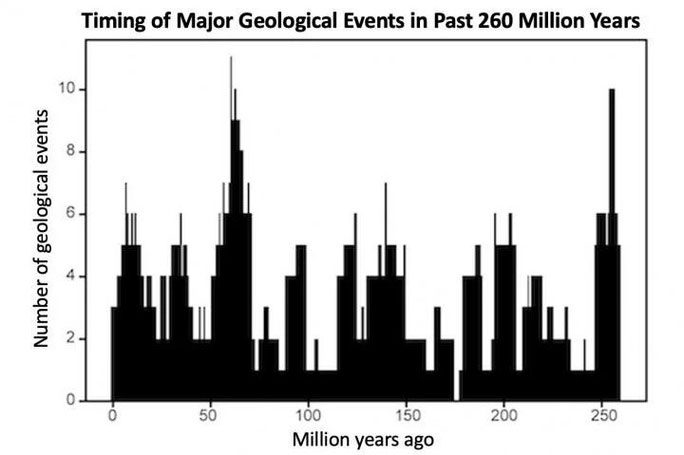A series of terrifying natural disasters and mass extinction events have revealed the heartbeat of the Earth—a brutal cycle of 27.5 million years.
“Many geologists believe that geological events are random over time, but our research provides statistical evidence for a common cycle: these geological events are correlated and not random“—stated geologist Michael Rampino from New York University, the lead author of the study, in an interview with Science Alert.
Dr. Rampino and his colleagues conducted an analysis of the ages and occurrences of 89 well-documented geological events over the past 260 million years.

Earth disaster chart over the past 260 million years – (Image: Geoscience Frontiers)
These events include a series of volcanic activities, continental basalt eruptions, ocean anoxia events, plate reconfigurations, and rising sea levels, closely linked to mass extinction events—those “apocalyptic days” for many species, in ways that human imagination and cinema could depict.
Mysteriously and frighteningly, they grouped the 89 disasters into 8 main event clusters that “changed the world,” creating a regular chart resembling a heartbeat with “disaster pulses.”
For about a century, sporadic studies have suggested that the Earth seems to experience major disasters every 30 million years, or 26.2 million years, or 30.6 million years.
However, with the latest calculations, the authors assert that the precise figure is 27.5 million years for each “disaster heartbeat” of the planet. This timing also consistently aligns eerily with mass extinction events.
The research team proposed several potential causes for the Earth’s disastrous “heartbeat”: due to a cycle of comet impacts or influenced by some “Planet X.”
However, in their latest publication in Geoscience Frontiers, they suggest that these cyclical pulses of tectonics and climate change could result from geophysical processes related to plate tectonic dynamics and periodic changes in the mantle.
It is also possible that the mantle and core of the Earth—those that drive plate tectonics—operate in cycles due to the influence of Earth’s movement within the Solar System and the galaxy.





















































